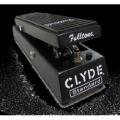I was originally going to start a review post about the Big Muff Pi, but I started thinking, which one should I review. There have been so many variations with the circuits over the years. This pedal is one of the most popular distortion pedals on the planet, now-a-days with the ‘heavier’ crowd.
I remember being introduced to this pedal when, I believe – and could be mistaken, the re-issue when it was the USSR Big Muff Pi Distortion / Sustainer back around 1998 or so. It was in a black chassis, 3 knobs and single switch. Knobs controlled volume, sustain and tone. I remember stepping on this box, and the distortion/gain was ferocious! The ability to crank massive amounts of gain causing unnatural ‘mean’ breakup was very appealing to me. But you don’t have to go fully in that direction and create a nice overdrive sound with it as well.
Now there are various versions of the Big Muff (Bass Big Muff Pi, Classic USA Big Muff Pi, XO Big Muff Pi w/Tone Wicker, Classic USSR Big Muff Pi, and the XO Little Big Muff Pi).
There are also collectors finding vintage Big Muffs and using them since the circuits changed throughout the years. I was able to find a interesting YouTube video showing some of the variations in tone. I thought it was very interesting to hear the changes and noise level
Some of the draw backs to the pedal. I think it’s pretty dang noisy (at least the USSR version is). The box is fairly large as well, but it’s nice to see the ‘Little Big Muff’ now. Same circuitry but small chassis. The prices for Big Muffs is nice. They usually range from $50 – $90 depending on what you get. Obviously this doesn’t include vintage pedals. At this cost, they’re worth having around.
If you have any thoughts about the other Big Muff models or have any experience with the vintage models, please comment!
Below are a few Big Muff Pi listings at Musician’s Friend.
|
|||||







